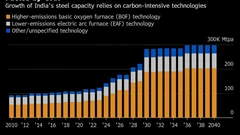EPA Biofuel-Blending Mandates to Hew to Earlier Proposals
(Bloomberg) -- The Biden administration is set this week to finalize biofuel-blending mandates that largely track plans it already proposed in December, according to several people familiar with the matter.
Environmental Protection Agency officials have told industry representatives to expect final 2022 quotas to be aligned with that initial proposal, which laid out a requirement for using 20.77 billion gallons of renewable fuel this year, said the people, who asked not to be named before a formal announcement.
The approach reflects a bid by the Biden administration to balance competing oil and refining industry interests, while trying to tame record-high gasoline prices and climbing food costs.
Yet it would be a blow to oil refiners who have argued for a significant reduction to the proposed 2022 targets, which could require biofuel to make up at least 11.8% of transportation fuels. Refining advocates have argued that would boost prices at the pump by raising industry compliance costs and straining the available pool of tradable credits known as RINs that are used prove quotas have been fulfilled. Most gasoline sold in the US is made up of 10% ethanol.
As proposed, the 2022 quota would represent the highest-ever biofuel target EPA has established under the renewable fuel program since its creation 17 years ago. That would be consistent with the Biden administration’s stated goals to get the US Renewable Fuel Standard program “back in growth mode,” after a surge of small refinery exemptions from quotas under former President Donald Trump.
The EPA has already rescinded 31 previously granted refinery waivers from 2018 requirements and is on track to deny dozens of pending exemptions from 2019, 2020 and 2021 biofuel-blending quotas. Yet it is also planning to offer small refineries flexibility in satisfying those earlier targets.
“We continue to see the Biden administration’s strategy as equivalent of offering refiners amnesty for market decisions made” during the Trump era, while setting a “strong and predictable” standard going forward, Benjamin Salisbury, director of research at Height Capital Markets, said in a research note for clients. That will “be supportive of RIN prices at or above implied value,” Salisbury wrote.
Spokespeople for the EPA didn’t respond to emailed requests for comment.
Read More: Spiking Gasoline and Food Costs Weigh on Biden Biofuel Plans
Ethanol and biodiesel producers have lobbied the White House to boost targets, arguing the proposed quotas underestimate potential production.
The EPA is on track to issue the measure Friday, fulfilling a deadline under a legal settlement with advocates for corn-based ethanol. The agency is set to retroactively lower already established targets for 2020, partly to adjust for pandemic-battered fuel demand that year.
The final rule is set to include slightly higher-than-proposed targets for biofuel blending in 2021, based on updated consumption data that year, two of the people said. The initial proposal, coming weeks before the end of the year, reflected projections of renewable fuel demand made months earlier.
(Updates with refinery exemption data and analyst comment from sixth paragraph)
More stories like this are available on bloomberg.com
©2022 Bloomberg L.P.
KEEPING THE ENERGY INDUSTRY CONNECTED
Subscribe to our newsletter and get the best of Energy Connects directly to your inbox each week.
By subscribing, you agree to the processing of your personal data by dmg events as described in the Privacy Policy.
More renewables news

House Committee Says It Finds Evidence of ‘Climate Cartel’

WEC Energy Offered $2.5 Billion US Loan for Renewable Projects

With Trump Looming, Biden’s Green Bank Moves to Close Billions in Deals

GE Vernova Expects More Trouble for Struggling Offshore Wind Industry

Climate Tech Funds See Cash Pile Rise to $86 Billion as Investing Slows

GE Vernova to Power City-Sized Data Centers With Gas as AI Demand Soars

Longi Delays Solar Module Plant in China as Sector Struggles

Australia Picks BP, Neoen Projects in Biggest Renewables Tender

SSE Plans £22 Billion Investment to Bolster Scotland’s Grid
















